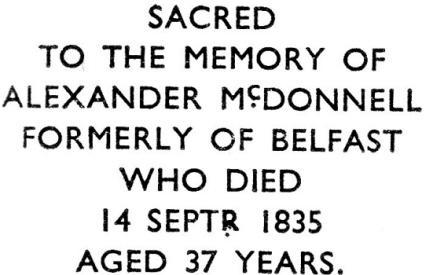
Edward Winter
No picture of Alexander McDonnell has ever been found, but many chess luminaries have investigated and debated how Alexander McDonnell’s surname should be spelt, and here we review the discussion.
A letter dated 27 April 1842 from William Harris of Richmond appeared on pages 11-12 of the 1843 Chess Player’s Chronicle:
‘A few days ago I visited that interesting “City of Tombs” Kensall [sic] Green Cemetery, for the purpose of discovering and paying my homage to the graves of those two lamented sons of Caissa – M‘Donnell and La Bourdonnais. After a long search I succeeded in finding that of the former, in a sequestered spot at the North-west corner of the cemetery, near a shady plantation of evergreens; it is a modest-looking grave, covered by a plain stone slab, on which is inscribed:
… Not far from thence, on the southern side of the cemetery, and near the chapel, is the grave of his great rival, the late Chess-King of Europe – La Bourdonnais; this is a very humble affair, consisting merely of a common head and foot stone, bearing this simple inscription:
The above information was repeated in the Chess Monthly, November 1859, pages 357-358, with the same spelling Kensall (instead of Kensal) but without any mention of Harris or the Chronicle.
When the 1846 Chronicle (pages 250-251) quoted a letter written by A.M. in 1834, it put McDonnell. The following volume (pages 362-363) gave two of his ‘unpublished games’, using the spelling M‘Donnell. Two further letters from him were published, courtesy of George Walker, on pages 13-14 of the January 1860 Chess Monthly, both being signed ‘Alex. M’Donnell’.
As shown above, within four years the Chess Player’s Chronicle had employed the spellings MacDonnell, McDonnell and M‘Donnell, and subsequent writers took their pick. In A History of Chess (Oxford, 1913) H.J.R. Murray gave MacDonnell, explaining in a footnote on page 880: ‘I follow the spelling of the name on MacDonnell’s tombstone at Kensal Green’. (As will be seen below, he later regretted the decision.) His posthumous book A Short History of Chess (Oxford, 1963 – but written in 1917 and updated by B. Goulding Brown and H. Golombek) had McDonnell.
A feature on pages 132-133 of CHESS, 14 December 1935 began as follows:
‘Saturday, 14 September marked the centenary of A. McDonnell’s death but, to the best of our knowledge, in the whole of chess literature, only one person noted the fact or paid any tribute to the memory of one of the greatest players Britain has ever produced. This was Mr H.W. Hawks [in the Newcastle Chronicle] …’
CHESS then quoted Hawks’ article, which repeated the Kensal Green inscriptions as given in the Chess Player’s Chronicle of 1843, but with MacDonnell now appearing as McDonnell.
Before the CHESS item the BCM (October 1935, page 460) had published its own brief notice:
‘14 September was the centenary of the death of Alexander M’Donnell, who was buried in Kensal Green Cemetery, London. Five years later his great rival, Louis La Bourdonnais, was also interred in the same cemetery. M’Donnell was the greatest English [sic] player of his time, and his matches created world-wide interest. A correspondent tells us that he finds the grave in excellent condition, the stone above it is very substantial, and about 20 years ago it was restored by the Good Companions Chess Problem Society, Philadelphia, Pa., USA.’
About a dozen years later the BCM hosted a debate about the spelling of the master’s name, after the November 1947 issue (pages 369-370) had given a game against Evans won by ‘MacDonnell’. The following appeared on page 13 of the January 1948 BCM:
‘Mr Goulding Brown points out that the name of de Labourdonnais’ great opponent was spelt McDonnell, and thus he himself spelt his name on the title page of his book on Economics. The mistake has probably become common because of the similarity of the name of the Rev. G.A. MacDonnell. Even Bird, on page 15 of his Chess History and Reminiscences gives both versions of the spelling to the older player.’
It might have been added that Bird also gave the wrong year of death (1837 instead of 1835).
On page 66 of the February 1948 BCM R.N. Coles responded:
‘Mr Goulding Brown raises a point of some small importance in the January issue. It is preposterous that we do not know how to spell the surname of one of our six greatest native chess masters. It has been quoted variously as McDonnell, MacDonnell and M’Donnell. The evidence he now adduces in favour of the first is very strong, but his cursory dismissal of the second as a mere confusion with a later player is hardly justified, for the second spelling is used on the tombstone, and tombstones are not usually erected except by someone who has been closely connected with the deceased during his lifetime. It would be interesting to know whether any readers can produce any other evidence of value, and particularly in connection with the third alternative spelling.’
The exchange of correspondence was rounded off by H.J.R. Murray on pages 82-83 of the March 1948 BCM:
‘Mr Goulding Brown is right as to the spelling of McDonnell’s surname, but his contemporaries often went wrong. Lewis wavered between M’Donnel and Macdonnel; Greenwood Walker used M’Donnell; George Walker M’Donnell and McDonnell, and finally started the legend that it was MacDonnell on his tombstone, and the Dictionary of National Biography followed suit. I regret to say that I adopted this in my History of Chess when I found it in the DNB. In 1934 I discussed the matter with J. Keeble and suggested to him that he should try and solve the question as he enjoyed this kind of research, and on 8 September 1934 he wrote me the following postcard from London:
“I have been in London earlier than I expected. Have today (Saturday) seen Alexander McDonnell’s grave. It is correctly engraved Mc, a small c with a dot under it. The inscription is wholly in capital letters. The cemetery books also record him as McDonnell. I could not find Labourdonnais’ grave.”’
In the above quote from Keeble the letter c was raised, with the dot just below it. The item also specified that the site was ‘a substantial stone lying down, about 18 in. thick’ and had the following reproduction of the text:

It will be noted that in the 1948 discussion nobody referred to ‘MacDonnell’ being reported as the tombstone spelling by William Harris in the early 1840s. Detailed information about the location of the graves of both McDonnell and Labourdonnais was given by David Hooper on pages 514-515 of the November 1986 BCM.
Another writer who became interested in the spelling controversy was C.J.S. Purdy. Two items in his magazine Chess World in 1955 (January, page 11 and November, page 236) added nothing new, but a significant article entitled ‘Alexander M‘Donnell, MacDonnell, McDonnell’ appeared on pages 170-171 of the August 1958 issue. Extracts are given below:
‘Some problems have little or no practical importance but gradually accumulate human interest because many people tackle them and fail. When at last someone succeeds, it is something. Mount Everest.
… The mystery has now been solved – and on the initiative of an Australian 12,000 miles from the scene of the crime. He is that indefatigable chess antiquary of Melbourne, Mr M.V. Anderson, possessor of the biggest chess library in the Antipodes. He appointed as local sleuth his nephew Mr E.J. Watson, who proved much more efficient than any of the antiquaries who have tackled the problem before. Above all, he unearthed a signature – two, in fact.
First of all, Mr Watson consulted – in the British Museum Library – the title-pages of all the books and pamphlets on political economy of which A.M. was the author. The titles are lengthy, and we content ourselves with listing the ways the author’s name is spelt, together with date of publication and the name of the publishers.
The 1833 pamphlet (in the form of a letter) ends with the (printed) words, ‘Your obedient Servant, A. McDonnell’. This would more or less compel Messrs Effingham Wilson to use that spelling on the title page.
So far it is quite evident that A.M. sanctioned the spelling of his name in three different ways. Did he himself sign it in different ways, like Shakespeare? The answer is yes. Sir John Murray of Messrs John Murray & Co. lent Mr Watson a letter from A.M. dated 23 December 1825, and by courtesy of Mr Anderson a photostat copy is before us. The signature reads:
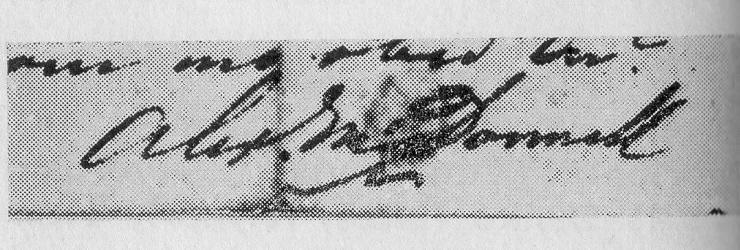
Alexr. M‘Donnell.
That was 1825. Subsequently, the Minute Books of the West Indian Committee of Merchants, of which A.M. was secretary, showed the name as McDonnell but not in the form of a signature.
Finally, we come to A.M.’s will of 2 September 1835. A photostat of the relevant portions is also before us. The will begins, in a scrivener’s copperplate hand, ‘This is the last will and testament of me Alexander MacDonnell’ and winds up with, ‘In witness whereof I the said Mac Donnell ….’ (with this time a clear space after the ‘Mac’). BUT the signature reads:

Alexr. McDonnell.
He died two weeks later, so it is fair to assume that whatever variant of his name he may have preferred at one time or another, he died Alexander McDonnell. There is no birth certificate, as civil registration of births in Ireland only began in 1864. In any case, a birth certificate is only conclusive for given names, in this case Alexander. Nobody is bound to spell his surname the way his father did, and it is rather the last spelling than the first that matters.
The spelling on the tombstone follows the signature on the will – McDonnell.’
(3398)
From David McAlister (Hillsborough, Northern Ireland):
‘Since I was first able to spell my name (in the 1950s) I have considered M plus a small c (Mc) to be interchangeable with M plus an apostrophe (M’). A friend who has an excellent knowledge of the Ulster Scots heritage has confirmed that until probably about 50 years ago M’ was frequently used (particularly in print) to represent Mc. My cuttings of Belfast News-Letter chess columns from the 1930s to the 1950s suggest that it was the standard rendition. Today, M’ has fallen out of use.
When I sign my name the small c is aligned with the top of the other letters, so that it actually looks quite like an apostrophe. I would therefore suggest that McDonnell and M’Donnell are in reality the same. MacDonnell, however, is a true variation in spelling.
The other issue is the full stop under the small c. Having checked this with my expert friend, I think that the full stop is decorative in nature or emphasizes the fact that the small c should appear at the top of the line of characters.’
Below is the only photograph of McDonnell’s grave known to us. It was published on page 202 of “Our Folder” (The Good Companion Chess Problem Club) 1 May 1921:
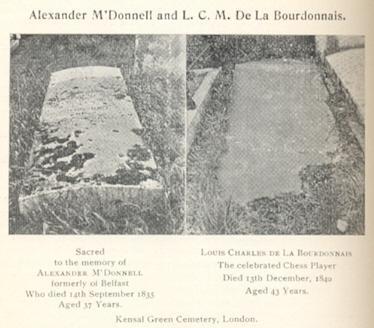
An article by G.H. Diggle on pages 277-281 of the July 1934 BCM marked the centenary of the La Bourdonnais v McDonnell matches; it was reprinted in part on pages 69-75 of The Treasury of Chess Lore by F. Reinfeld (New York, 1951). In Newsflash in June and July 1984 Diggle wrote a further feature on the matches. Given on pages 3-6 of volume two of Chess Characters (Geneva, 1987), the two parts are reproduced below.
June 1984:
‘This month marks the 150th Anniversary of a famous match series which (wrote R.N. Coles) “still bears comparison with that of any later age”, when, in the words of George Walker, “La Bourdonnais came to London with the roses of June” and encountered the great Irishman Alexander McDonnell in 85 games lasting all through the Summer (La B. 46, McD. 26, Drawn 13). These games were unevenly split between six matches, but the conditions of play were very loose – there were no seconds, there was no time-limit, the stakes were “very small” and, amazing to relate, the whole splendid series would never have been preserved for us but for one man. William Greenwood Walker, the aged Secretary of the Westminster Chess Club, was “little of a chessplayer” but a fanatical “fan” of McDonnell’s, and throughout the whole 85 games the old gentleman sat beside the English Champion “with spectacles on nose” eagerly taking down the moves and “scarce daring to breathe lest the conceptions of his hero should miscarry”. George Walker (not a relative) wrote of him: “He died full of years – we would well have spared a better – aye – many a better man.”
The Champions played every day of the week except Sunday, usually from noon till 6 or 7 p.m., but never more than one game at a sitting. Many games were adjourned till next day. Indeed, McDonnell was (except Williams) the slowest player this country ever produced. “I have seen him an hour and a half”, writes George Walker, “and even more, over a single move, and I once timed La Bourdonnais 55 minutes”. But in those spacious days this seems to have impressed rather than repelled the spectators, who (even if themselves not sufficiently advanced to appreciate the quality of the play) felt that “this was indeed chess”, far superior to such weasel encounters of the past as that in 1821 between Lewis and Deschapelles, who played their three games match “before dinner”.
The circumstances, as distinct from the conditions, under which the matches were played strongly favoured McDonnell. He was a very comfortably off bachelor who held the post of Secretary of the West India Committee of Merchants with a salary of £1,200 a year. As his duties were to watch the progress of Bills affecting the West Indies, he had work to do only when the Houses of Parliament were sitting (in fact, the Palace of Westminster was burnt down in the famous 1834 fire, which must have occurred during the match). La Bourdonnais, though of a noble family and heir to an old estate – in the earlier years of his marriage he possessed “un château, cinq domestiques, et deux équipages” – impetuously lost all his money in a building speculation and came down to £60 a year as Secretary of the Paris Chess Club and what he could make as a professional at the Café de la Régence. During the McDonnell matches his boisterous resilience was such that he would follow up a seven-hour struggle by playing for half-a-crown a game against all-comers till long after midnight.
McDonnell only lived a year after the great encounter, being stricken with Bright’s Disease at the age of 37. Later, in Le Palamède, La Bourdonnais wrote handsomely about him as the greatest player he had ever encountered (he did add, as a rather hurried afterthought, except M. Deschapelles, but this was a sop to his touchy old predecessor). No portrait of McDonnell has survived and the only one of La Bourdonnais (the frontispiece of Le Palamède, 1842) was described by Staunton (Chess Player’s Chronicle, volume two, page 159) as a “lithographic enormity”, though Staunton never actually saw either of the two masters.
As many varying opinions on the actual games have been expressed by experts, the BM (having just played through the whole series) hopes next month to report on his “findings”, which will no doubt stagger the Chess World and set everybody right.’
July 1984:
‘To play through the 85 La Bourdonnais-McDonnell games, covering just over 3,500 moves aside, is rather like crossing the Atlantic in stormy weather, or at best choppy seas with deceitful calms. And to annotate them, even for an expert, must be a nightmare. Staunton himself, who did so (Chess Player’s Chronicle, volumes 1-3), really sums up the series in a famous note to Game 21: “It seems utterly impossible for either player to save the game.” Such were the complications he encountered that even he, never afraid of deep analysis, was sometimes driven to dodge the “heavy seas” and pick on shallower water where he could say something when there was nothing to be said: “The youngest player will perceive that White would have lost his queen had he imprudently captured the queen’s pawn.”
Both masters were of the same temperament, daring in attack and ingenious in defence. McDonnell in particular could always start something out of nothing. And throughout the six matches both completely ignored the state of the score, playing each game solely to win, and even (there being no time-limit) to win like human computers by seeing every variation. Though in this they never succeeded, in some games, notably the 47th, they came magnificently close to it. During this great struggle, in which the middle-game “revels” begin as early as the ninth move with every piece still on the board, neither player misses anything throughout a colossal mêlée lasting up to the 20th, when the position seems to collapse under its own weight and the two queens and two minor pieces aside perish in the debris. But the survivors on both sides are on their feet again in an instant, and a new phase begins – an enthralling race between two rook-supported clusters of passed pawns, ending in a hair-raising French victory in 53 moves. While croaking “moderns” will condemn this game (“Wot? No logical Theme?” or “Wot? No planned connection between the first half and the second?”), the BM can only growl defiantly, “Let them croak!”
Of the 85 games, the following have been agreed by generations of critics to be “the greats”: games 17, 47, 62 and 78 won by the Frenchman and 5, 21, 30, 50 and 54 won by McDonnell. To these the BM would add 15 and 40 (La B.) and 85 (McD.). The “Immortal 50th” has always been awarded “the Oscar”, but this game was “all McDonnell”, and there are other good candidates in which both masters were on the top of their form. In some one feels the wrong man won; though McDonnell lost 40 (a King’s Gambit in which he gave up two pieces in the first nine moves), he actually harried La Bourdonnais with his inferior force for 22 more moves before he was finally shaken off by the Frenchman’s knife-edge accuracy.
But only 12 “Royal Battles” have been mentioned. What of the 73 “plebeians” remaining? Many are curate’s eggs, excellent up to more than half-way through, then addled by blunders, McDonnell being the worse offender. But others are rated by “H.G.” in A History of Chess as thoroughly bad eggs throughout, and this is difficult to dispute. In his disastrous first match McDonnell, playing White against the Sicilian, repeatedly makes such a crude hash of the opening that his king (with both his rooks and bishops still unmoved) is forced to make a fatuous excursion via KB2 to KR3, where he is speedily run over like a stray cow on a railway line. As for La Bourdonnais, it is hard to avoid the conclusion that before, instead of after, he played the 58th and 83rd games, he had, as was his nightly custom, “sent pint after pint of Burton Ale Beer into the hold”.
The whole series is given in Walker’s “Thousand Games” – the 47th game described above also appears in Staunton’s Laws and Practice of Chess, Greenwell’s Chess Exemplified, R.N. Coles’ Battles-Royal of the Chessboard, and the BCM, July 1934 with notes by Sir Stuart Milner-Barry.’
(7369)
See also De la Bourdonnais versus McDonnell, 1834 by Cary Utterberg (Jefferson, 2005) and our feature article Louis Charles Mahé de Labourdonnais.
John Townsend (Wokingham, England) writes:
‘In Bell’s Life in London, 13 November 1842 George Walker recalls in a reply to a correspondent that Alexander McDonnell (1798-1835) had played an unusual variation of Alekhine’s Defence:
“We have seen McDonnell as his first move, his adversary having begun first, and pushed out king’s pawn two, commence with king’s knight thus to bishop’s third, courting his opponent’s pushing king’s pawn on him, and then coolly retiring knight home, “biding his time”. He used to say his adversary’s king’s pawn was weakened, by being thus prematurely advanced.”
This commentary on the variation 1 e4 Nf6 2 e5 Ng8 suggests that McDonnell possessed some understanding of what we would now regard as hypermodern principles of play.
I note your feature article on Alekhine’s Defence. Had Allgaier already explained any such principles in the course of his analysis?’
Below is the passage by Walker referred to, from page 2 of the 13 November 1842 edition of Bell’s Life in London:
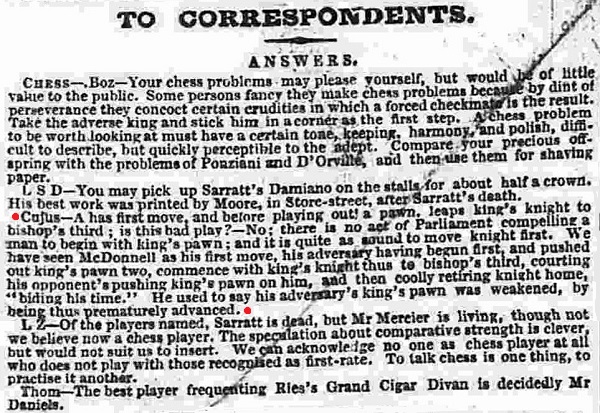
Mr Townsend notes that the item can also be viewed at the Chess Archaeology website as part of the Jack O’Keefe Project. (The Project, we add, represents an astounding amount of work of great value.)
The answer to our correspondent’s question about Allgaier is that no explanation of principles was offered when the moves 1 e4 Nf6 were given in Tafel 9 of his book Neue theoretisch-praktische Anweisung zum Schachspiele (Vienna, 1819):
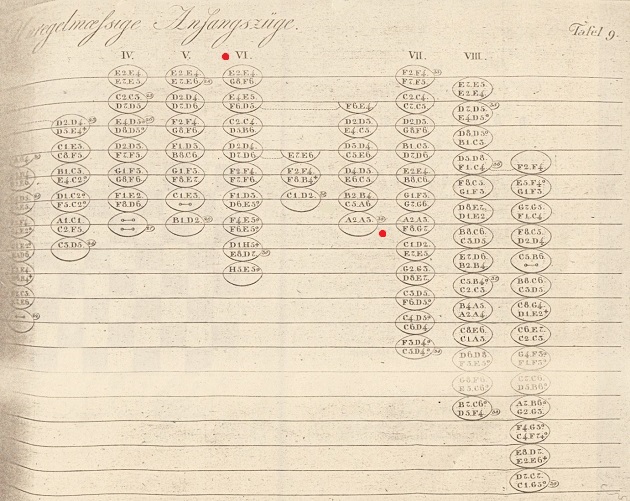
The relevant notes (30, 31 and 32) can be read in the Google Books scan of the work, on page 108.
The connection between Alexander McDonnell and hypermodernism is intriguing.
(9667)
From page 33 of CHESS, October 2016:
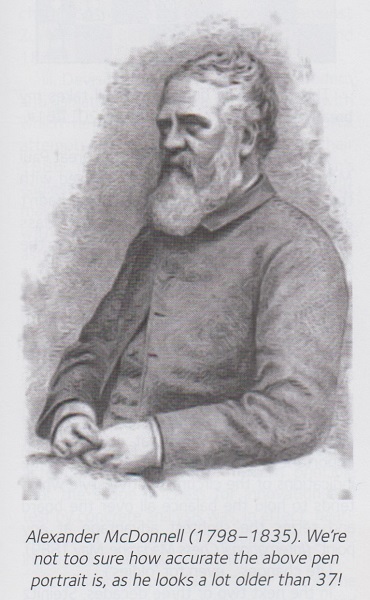
This is another (gross) case of mistaken identity. As noted in our feature article on Alexander McDonnell, no picture of him is known. The above illustration in CHESS, given in C.N. 3974 and in Excuses for Losing at Chess, was the frontispiece to Chess Life-Pictures by George Alcock MacDonnell (London, 1883):
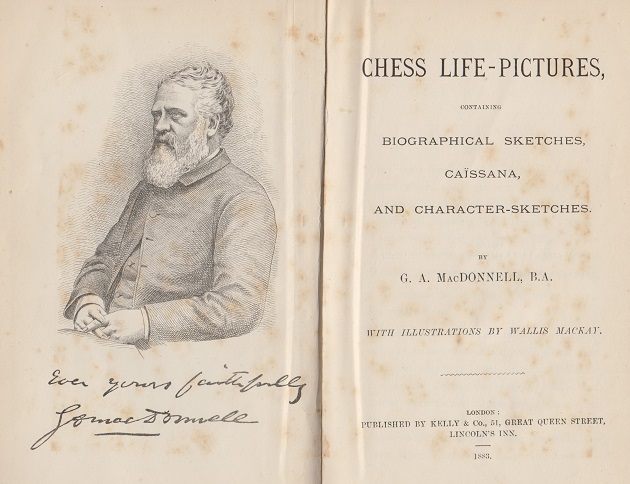
(10131)
Our correction was reported on page 43 of CHESS, November 2016.
An extract from a column by George Koltanowski on page 10 of the Corpus Christi Caller-Times, 20 May 1962:
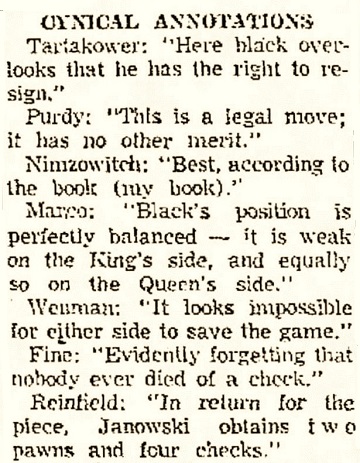
As ever, factual information about such quotations is sought. The Marco one was discussed in C.N. 5248, and the remark ascribed to Reinfeld should also mention Fine. It appeared on page 141 of the book on Lasker which they co-authored.
It is, though, the Wenman item that deserves particular attention, since it brings to mind a remark widely attributed to Staunton. For example, an article by G.H. Diggle reproduced in C.N. 7369 [see above] stated with regard to writers who annotated the 1834 Labourdonnais v McDonnell games:
‘Staunton himself, who did so (Chess Player’s Chronicle, volumes 1-3), really sums up the series in a famous note to game 21: “It seems utterly impossible for either player to save the game.”’
In an article about the Labourdonnais v McDonnell series on pages 277-281 of the July 1934 BCM Diggle wrote:
‘Some of their complications have driven annotators to despair. Staunton himself in one case can do no more than helplessly declare: “It seems utterly impossible for either player to save the game.”’
The article was reproduced on pages 69-75 of The Treasury of Chess Lore by Fred Reinfeld (New York, 1951).
Presenting game 21 on pages 94-95 of Lessons in Chess Strategy (London, 1968) W.H. Cozens wrote:
‘Staunton’s note after White’s 29th move makes an apt comment: “It now seems hardly possible for either player to save the game.”’
However, pages 83-84 of The World of Chess by Anthony Saidy and Norman Lessing (New York, 1974) had the following with regard to a different game (50):
‘Beyond inserting a number of exclamation points it is useless to try to annotate this wildly uninhibited game. Howard Staunton, the famous English player, made the attempt some years later, only to give up with the historic remark: “It seems utterly impossible for either player to save the game!”’
It took us a while to find confirmation of Staunton’s words (in connection with game 21), on page 133 of his posthumous book Chess: Theory and Practice (London, 1876). Below is the relevant page in a late edition (London, 1920, published under the title The Laws and Practice of Chess):
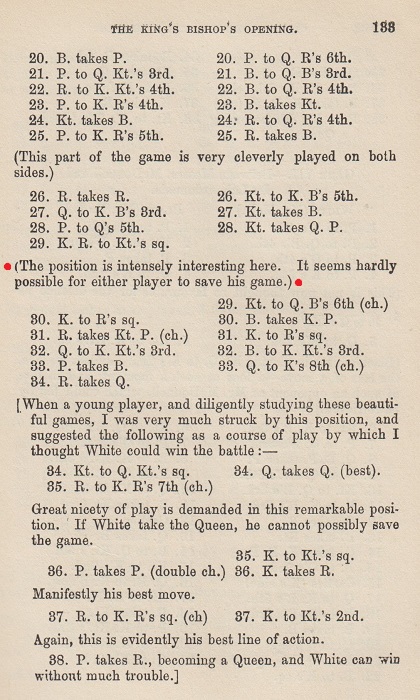
That leaves the question of why Wenman’s name was introduced for a similar remark, and we can give a citation from his book One Hundred and Seventy Five Chess Brilliancies (London, 1947):
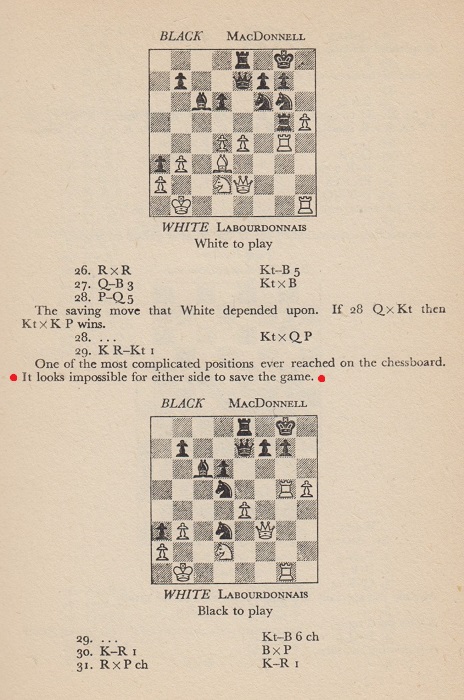
That unnumbered page is game 53 in Wenman’s book and is, of course, part of his coverage of the above-mentioned game 21 in the Labourdonnais v McDonnell series.
(10171)
Further to the reference above to an 1834 letter from McDonnell published on pages 250-251 of the Chess Player’s Chronicle, 1846, the full text is given here:
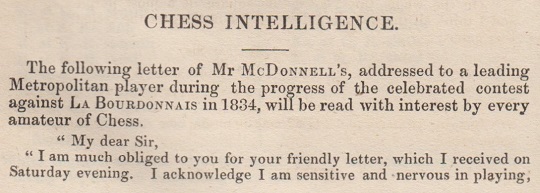
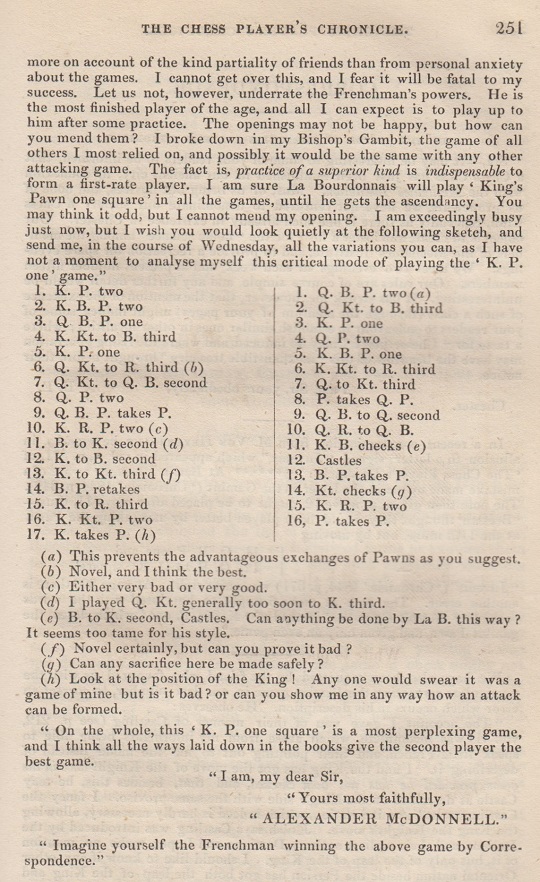
The moves discussed: 1 e4 c5 2 f4 Nc6 3 c3 e6 4 Nf3 d5 5 e5 f6 6 Na3 Nh6 7 Nc2 Qb6 8 d4 cxd4 9 cxd4 Bd7 10 h4 Rc8 11 Be2 Bb4+ 12 Kf2 O-O 13 Kg3 fxe5 14 fxe5 Nf5+ 15 Kh3 h5 16 g4 hxg4+ 17 Kxg4.
Page 245 of Amusements in Chess by Charles Tomlinson (London, 1845) stated that the recipient of the letter was ‘Mr Walker’.
Another letter, written by McDonnell on 7 July 1834, was quoted on page 40 of the Westminster Papers, 2 July 1877, and more details are sought:
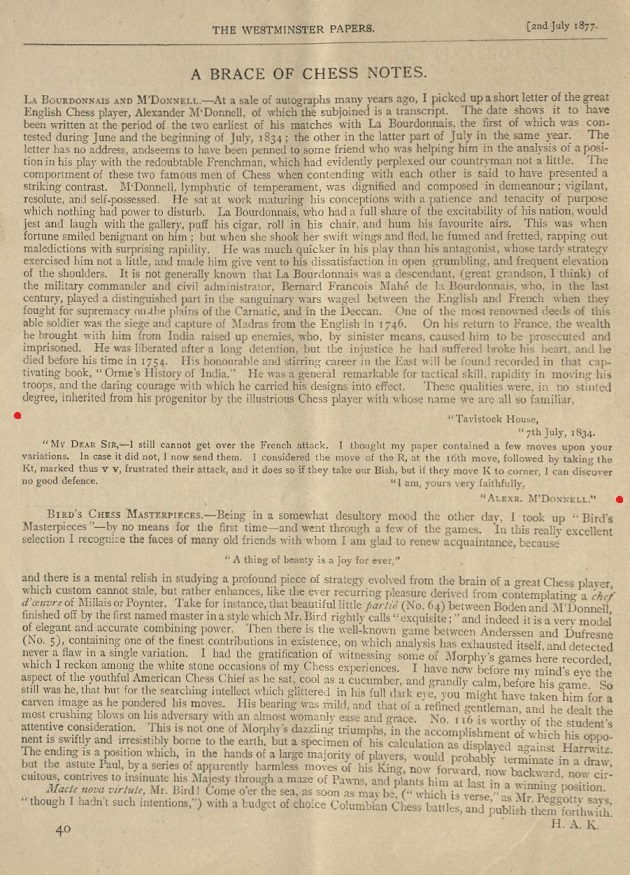
(10394)
From John Townsend:
‘In his will (National Archives, PROB 11/1855/197) Alexander McDonnell (/MacDonnell) identified as his brother Thomas MacDonnell, of Belfast, a barrister. The only Belfast barrister of that name at that time was a graduate of Trinity College, Dublin, who, accordingly, has an entry in Alumni Dublinenses (edited by G.D. Burtchaell and T.U. Sadleir, second edition, Dublin, 1935).
On page 533, the entry for “McDonnell, Thomas” states that he was admitted on 7 November 1808, aged 15, a son of Thomas, a merchant, having been born in the county of Antrim; he obtained his Bachelor of Arts degree in Spring 1813, was called to the Irish Bar in 1816 and later became a QC. The entry concludes by referring the reader to Frederic Boase’s Modern English Biography.
Boase (volume II, page 590), in an entry for “McDonnell, Thomas”, supplies the additional information that he was born in 1793, was a scholar at Trinity in 1811, became a QC on 1 July 1837 and a crown prosecutor for the county of Down, and died at Eglantine Hill, near Belfast, on 25 September 1878. The above information about the barrister, which I believe will be new to chess historians, builds on earlier research by James O’Fee (including Researching Alexander McDonnell Part 9) and proves that the father of the chessplayer, Alexander, was Thomas McDonnell (/MacDonnell), a merchant, and not Alexander MacDonnell, a Belfast physician.’
(10662)
A further contribution from John Townsend:
‘Is anything at all known about the physical appearance of Alexander McDonnell, or about what he did before embarking upon his career as a merchant? A little information can perhaps be gleaned from a Royal Artillery drivers’ description book deposited in the National Archives at Kew (WO 69/654).
Folio 37 includes, on the fifth line, an entry for the driver Alexr McDonell [sic], who was enlisted by Lieutenant Clark on 1 February 1814, in Lisburn (Ireland), aged 15. He is described as five feet three inches in height, with a swarthy complexion, brown hair and blue eyes, having been born in Belfast, in the county of Antrim. He had no trade or calling, and was first mustered in the 7th Battalion, posted to Troop “B”. He was discharged on 28 February 1817 in Ireland.
Was this driver the celebrated chessplayer? His name, age and place of birth are all plausible, but would one not expect the son of a merchant to join the army as an officer?
In C.N. 10662 the father of the chessplayer was identified as Thomas McDonnell (/MacDonnell), a merchant. James O’Fee, in his article Still Researching Alexander McDonnell 2010: Part 4, cited a death notice in the Belfast News Letter announcing that Mr Thomas M’Donnell, a merchant of Belfast, had died on 17 January 1809.
The website Findagrave reports a memorial in Knockbreda Cemetery, Belfast to a Thomas McDonnell who died on that date.
The same memorial also records Mary McDonnell (1767-98), the wife of Thomas. From this one might infer that the chessplayer’s mother died at approximately the time, i.e. 1798, when, his own 1835 burial record suggests, he was born. The possibility arises of her death in child-birth. It may also be concluded that Alexander McDonnell became an orphan in 1809, following his father’s death, and in those circumstances a spell as a driver in the Royal Artillery becomes less difficult to envisage. Meanwhile, more evidence is needed to determine whether the young soldier in the record book became the man who was later famous as the adversary of Labourdonnais.’
John Townsend writes:
‘The following review of William Greenwood Walker’s A Selection of Games of Chess, actually Played in London by the late Alexander McDonnell, Esq., appeared in the Metropolitan Magazine, October 1836, page 46. The article is also in large measure a tribute to Alexander McDonnell, who had recently died.
“When we read this title we were struck with consternation at the word ‘late’, for it was but a few short months ago that we ourselves contended with Mr M’Donnel, certainly with more profit than success. Alas! it is no odds now what odds he gave us then, for death, too truly, makes all things even. However, we cannot – it would be injustice to refrain from bearing our testimony to the gentlemanly deportment, the urbane manners, and the high intellect of this first of English chessplayers. The evenness of his nature was singular; – he had neither the proud reserve of success, nor the moroseness of disappointment. He could not but be conscious of his superiority, but he wore it with the most unpretending air of good-humour that we ever beheld. He was very unlike many of his contemporaries, greedy of the paltry gain of the stakes, fearful to play with a competitor of approximating excellence, or sullen and taciturn in his manners. We are sorry to say that the besetting sin of some, a few, of the principal chessplayers, was a want of suavity in the general tone of their manners, to those beneath them in skill supercilious, of their equals jealous, of those above them envious. But none of this could M’Donnel be, for he was, in the most lofty sense of the word, a gentleman. But to the work before us. The chessplaying world are much indebted to Mr Walker for putting these very excellent games upon record. In them the observer will see all the variations of the most scientific plans, – the long calculation, the sudden surprise, the well-concealed ambush. Many of the games are exquisite, both as to the skill of the attack and the defence; and we conceive nothing more likely to improve a student of chess than sitting down quietly and playing them over on the board, con amore, as they are set down in the work. Really, we recommend this volume to general acceptation.”
The writer of the review, Edward Howard (died 1841), was the sub-editor of the Metropolitan Magazine, in addition to being a novelist. He was a member of the Westminster Chess Club and was mentioned on page 3 of the Morning Post, 3 February 1835 in connection with the visit to the club of the Turkish Ambassador. Only a single game was played on the occasion, when “the Pacha’s secretary” beat Howard “in good style”. However, the latter was described as “a player to whom a first-rate can give a rook”.’
(11412)
***
There are innumerable books and disks which assert that Labourdonnais lost the following game to McDonnell in their 1834 match: 1 e4 e5 2 f4 exf4 3 Nf3 g5 4 Bc4 g4 5 Nc3 gxf3 6 O-O c6 7 Qxf3 Qf6 8 e5 Qxe5 9 Bxf7+ Kxf7 10 d4 Qxd4+ 11 Be3 Qg7 12 Bxf4 Nf6 13 Ne4 Be7 14 Bg5 Rg8 15 Qh5+ Qg6 16 Nd6+ Ke6 17 Rae1+ Kxd6 18 Bf4 mate.
An ‘historical correction’ from Harry Ruckert of New York was published in the readers’ letters section of the December 1955 Chess Review (page 353):
‘Have you ever wondered why a great master like Labourdonnais let himself be mated in 18 moves in that Muzio Gambit you see so often in chess books and magazines? (e.g. 500 Master Games of Chess, by Tartakower and du Mont, game 220, page 284).
The answer is: he didn’t! L. Elliott Fletcher, author of Gambits Accepted, writes that McDonnell’s opponent in this game was really a semi-anonymous player, given as “R*ll***n”, and not Labourdonnais. Mr Fletcher made this discovery in the British Museum in the course of researches for his forthcoming The Immortal Eighty-five, making available again all the games of these great matches in the 1830s.
It seems there were three authentic Muzios (one the famous 54th game) and, in all, McDonnell played his own variation, still called the “McDonnell Attack”: 1 e4 e5 2 f4 exf4 3 Nf3 g5 4 Bc4 g4 5 Nc3 gxf3 6 Qxf3. But Mr Fletcher thinks he would have played the “almost reckless” 6 O-O only against a weaker player – and at odds of queen rook.
So, if you have a printed score of this game, do the ghost of Labourdonnais a favor and scratch out his name, substituting: “R*ll***n”.’
It appears that the ‘forthcoming’ work The Immortal Eighty-five never came forth, although we possess a copy of the typescript. In any case, the matter of the Muzio Gambit brevity had already been covered by G.H. Diggle five years previously, in a letter published on page 291 of the September 1950 BCM:
‘In Mr Reinfeld’s beautiful Treasury of British Chess Masterpieces there are two brilliant Muzios given as match games won by McDonnell against Labourdonnais. The first is certainly the 54th game of the immortal series; but in the second McDonnell’s real opponent (to whom he gave the odds of queen’s rook) was “Mr R*ll****n” (probably Rolliston), one of the amiable asterisk-ridden amateurs of the 1830s (see George Walker’s Chess Studies, Game No. 202, and Greenwood Walker’s Selection of Games Played by McDonnell, Book I, Game No. 4, also the Appendix, where “J. Rolliston, Esq.” appears on Greenwood’s list of subscribers).
Mr Reinfeld is not to blame – the fault lies on this side of the Atlantic, where over 60 years ago an English author (no longer here to defend his strange conduct) reprinted the game, cast poor Mr Rolliston overboard, substituted Labourdonnais instead, and (most monstrous of all) actually gave McDonnell back his queen’s rook – as though the great master really needed it! The game has passed for a “Labourdonnnais-McDonnell” ever since.’
(2600)
Discussing an 18-move Muzio Gambit game which has incorrectly been labelled a loss by Labourdonnais, C.N. 2600 (see above) quoted from page 291 of the September 1950 BCM G.H. Diggle’s attribution of the mistake to “an English author (no longer here to defend his strange conduct)”. We can add now that on page 139 of the May 1967 BCM Diggle identified him:
‘The “villain” who, as far as I know, first printed the game as a “Labourdonnais v MacDonnell [sic]” was W.J. Greenwell (Chess Exemplified, Leeds, 1890). But it is possible that he may have copied the game in good faith from some earlier writer.’
(2887)
***
‘Labourdonnais’, ‘De La Bourdonnais’ and many variants exist in chess literature, and Ulvi Bajarani (Baku) asks whether a preferred spelling can be determined.
C.N. 5149 showed an image from Worlds of Chess Champions, a booklet issued by the Cleveland Public Library in October 2003:
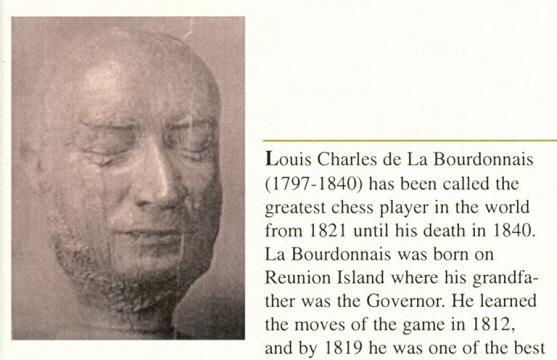
The present item leaves aside his forenames (Louis Charles Mahé can be found in various combinations) to focus on the surname. First, his signature on an 1838 letter shown in C.N.s 7379 and 7383:
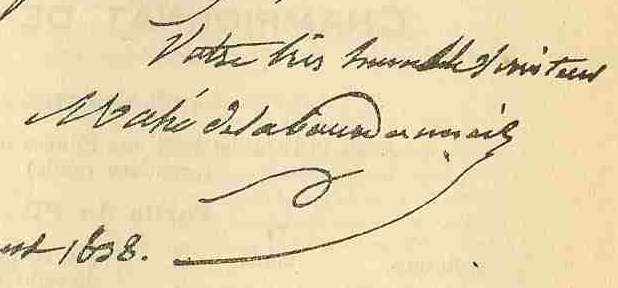
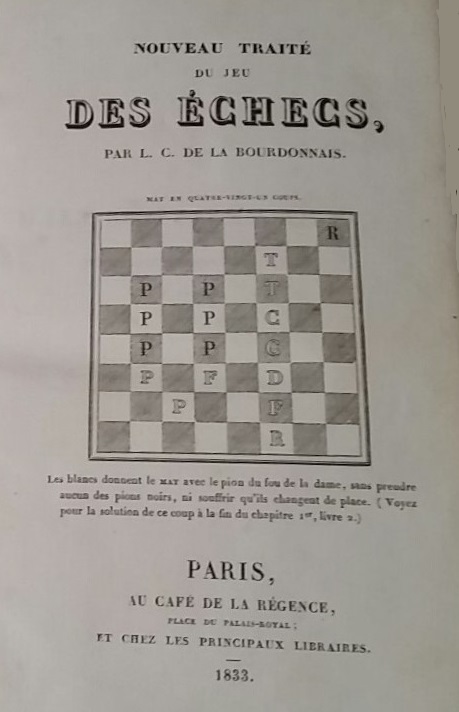
Next, his magazine, Le Palamède:
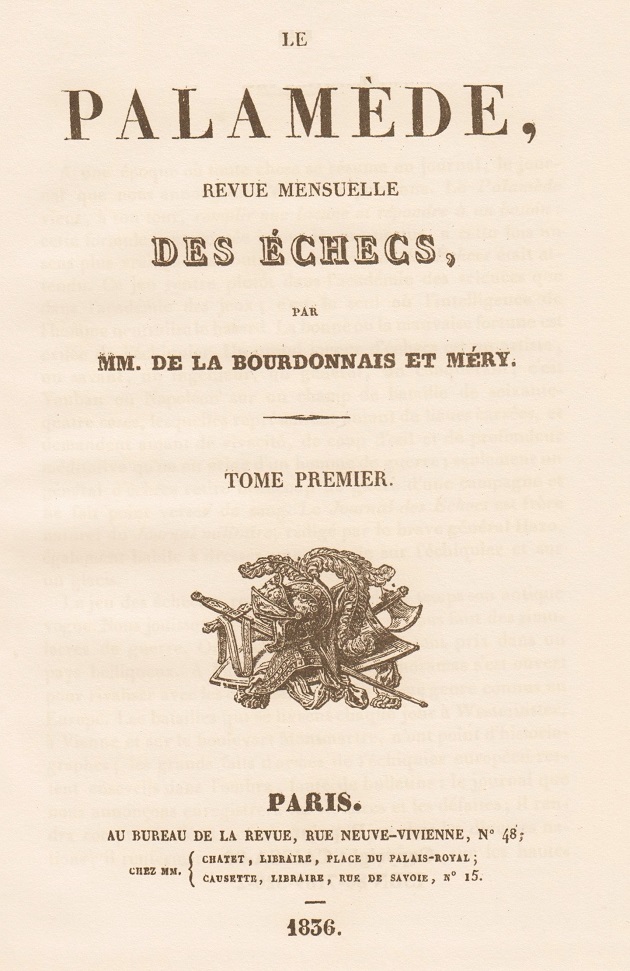
The introduction to the first issue had, on pages 6-7, ‘M. de la Bourdonnais’. An announcement on page 35 was signed ‘DE LA BOURDONNAIS’. Pages 428-429 had ‘M. de La Bourdonnais’ a number of times. Page 15 of the first 1842 volume of Le Palamède referred to ‘M. Mahé de Labourdonnais’, but ‘Labourdonnais’ appeared increasingly in the magazine.
Tolerance of several spellings thus seems advisable, but what about simply ‘Bourdonnais’? At the conclusion of a review of The Oxford Companion to Chess by David Hooper and Kenneth Whyld (Oxford, 1984), G.H. Diggle, the Badmaster, wrote in the December 1984 Newsflash:
‘The BM has left his one “grouse” till last – the eminent German master von der Lasa is always referred to as plain “Lasa”; worse still, the great La Bourdonnais appears throughout as “Bourdonnais”. To a diehard Tory like the BM, this “La-lopping” and cutting down the timber of the aristocracy has a nasty egalitarian look.’
The book review was reproduced on pages 12-13 of volume two of Chess Characters by G.H. Diggle (Geneva, 1987).
Ulvi Bajarani (Baku) asks whether the exact year, let alone the exact day, of Labourdonnais’ birth can be established.
C.N. 4070 reproduced from page 202 of “Our Folder” (The Good Companion Chess Problem Club), 1 May 1921 a photograph of the master’s grave in London with a caption indicating that he died on 13 December 1840, aged 43. However, the obituary of Labourdonnais by Saint-Amant in Le Palamède stated:
‘Labourdonnais qui était né en 1795, l’année même de la mort de Philidor, a été comme lui mourir à Londres, dans un état voisin de la pauvreté.’
The obituary was on pages 15-19 of the first issue of Le Palamède following its resumption, circa December 1841, after more than a year’s absence. An endnote referred to prior publication of the obituary:
‘Cet article avait été publié dans les feuilles quotidiennes en février 1841, deux mois après la mort de Labourdonnais.’
The matter will be pursued in future items with, we hope, readers’ assistance.
(11428)
John Townsend writes:
‘There is an interesting, though not always accurate, article about Labourdonnais the chessplayer in P.J. Levot’s Biographie Bretonne (volume II, Paris, 1857, pages 60-61). A footnote mentions that Louis-François Mahé de la Bourdonnais, the son of the Governor of the Ile de France and Bourbon, had a son Pierre-Marie-Philippe-Charles, who was born on 9 November 1773 and married, on 16 April 1796, Jeanne-Françoise Bunel. This couple is identified as the parents of the famous chessplayer, regarding whose birth the following is stated:
“On a quelques raisons de croire que Louis-Charles, issu de leur mariage, naquit, l'année suivante, à Paris, rue ou impasse Féron, où sa mère avait un hôtel, qu'elle a vendu depuis.”
The next sentence mentions, however, the absence of proof as to his place of birth. Although the passage quoted is rather vague as to the time of the birth, this possible answer has the advantage of associating the birth with a specific marriage, allowing for a suitable interval.
Birth during 1797 would make his age at death 43. That is the age given in the index of deaths of the General Register Office, in the burial register of All Souls General Cemetery, Kensal Green, where he was buried on 17 December 1840, and it is also the age which appeared on the headstone at his grave.
There are two references in Le Palamède to 1795 as his year of birth, but it is not explained how that year was arrived at, or who his parents were.’
(11492)
To the Chess Notes main page.
To the Archives for other feature articles.
Copyright: Edward Winter. All rights reserved.